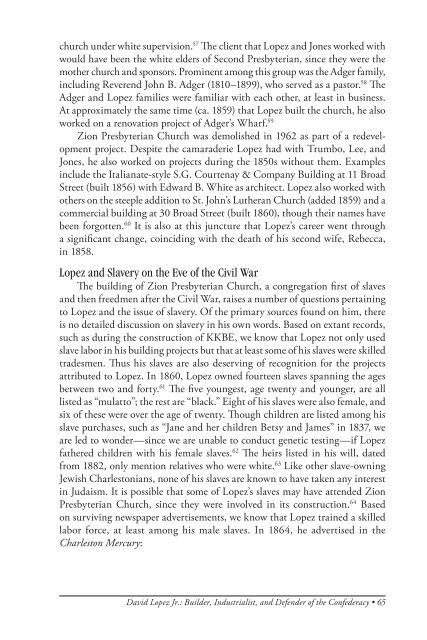American Jewish Archives Journal, Volume 64, Numbers 1 & 2
American Jewish Archives Journal, Volume 64, Numbers 1 & 2
American Jewish Archives Journal, Volume 64, Numbers 1 & 2
You also want an ePaper? Increase the reach of your titles
YUMPU automatically turns print PDFs into web optimized ePapers that Google loves.
church under white supervision. 57 The client that Lopez and Jones worked with<br />
would have been the white elders of Second Presbyterian, since they were the<br />
mother church and sponsors. Prominent among this group was the Adger family,<br />
including Reverend John B. Adger (1810–1899), who served as a pastor. 58 The<br />
Adger and Lopez families were familiar with each other, at least in business.<br />
At approximately the same time (ca. 1859) that Lopez built the church, he also<br />
worked on a renovation project of Adger’s Wharf. 59<br />
Zion Presbyterian Church was demolished in 1962 as part of a redevelopment<br />
project. Despite the camaraderie Lopez had with Trumbo, Lee, and<br />
Jones, he also worked on projects during the 1850s without them. Examples<br />
include the Italianate-style S.G. Courtenay & Company Building at 11 Broad<br />
Street (built 1856) with Edward B. White as architect. Lopez also worked with<br />
others on the steeple addition to St. John’s Lutheran Church (added 1859) and a<br />
commercial building at 30 Broad Street (built 1860), though their names have<br />
been forgotten. 60 It is also at this juncture that Lopez’s career went through<br />
a significant change, coinciding with the death of his second wife, Rebecca,<br />
in 1858.<br />
Lopez and Slavery on the Eve of the Civil War<br />
The building of Zion Presbyterian Church, a congregation first of slaves<br />
and then freedmen after the Civil War, raises a number of questions pertaining<br />
to Lopez and the issue of slavery. Of the primary sources found on him, there<br />
is no detailed discussion on slavery in his own words. Based on extant records,<br />
such as during the construction of KKBE, we know that Lopez not only used<br />
slave labor in his building projects but that at least some of his slaves were skilled<br />
tradesmen. Thus his slaves are also deserving of recognition for the projects<br />
attributed to Lopez. In 1860, Lopez owned fourteen slaves spanning the ages<br />
between two and forty. 61 The five youngest, age twenty and younger, are all<br />
listed as “mulatto”; the rest are “black.” Eight of his slaves were also female, and<br />
six of these were over the age of twenty. Though children are listed among his<br />
slave purchases, such as “Jane and her children Betsy and James” in 1837, we<br />
are led to wonder—since we are unable to conduct genetic testing—if Lopez<br />
fathered children with his female slaves. 62 The heirs listed in his will, dated<br />
from 1882, only mention relatives who were white. 63 Like other slave-owning<br />
<strong>Jewish</strong> Charlestonians, none of his slaves are known to have taken any interest<br />
in Judaism. It is possible that some of Lopez’s slaves may have attended Zion<br />
Presbyterian Church, since they were involved in its construction. <strong>64</strong> Based<br />
on surviving newspaper advertisements, we know that Lopez trained a skilled<br />
labor force, at least among his male slaves. In 18<strong>64</strong>, he advertised in the<br />
Charleston Mercury:<br />
David Lopez Jr.: Builder, Industrialist, and Defender of the Confederacy • 65
















